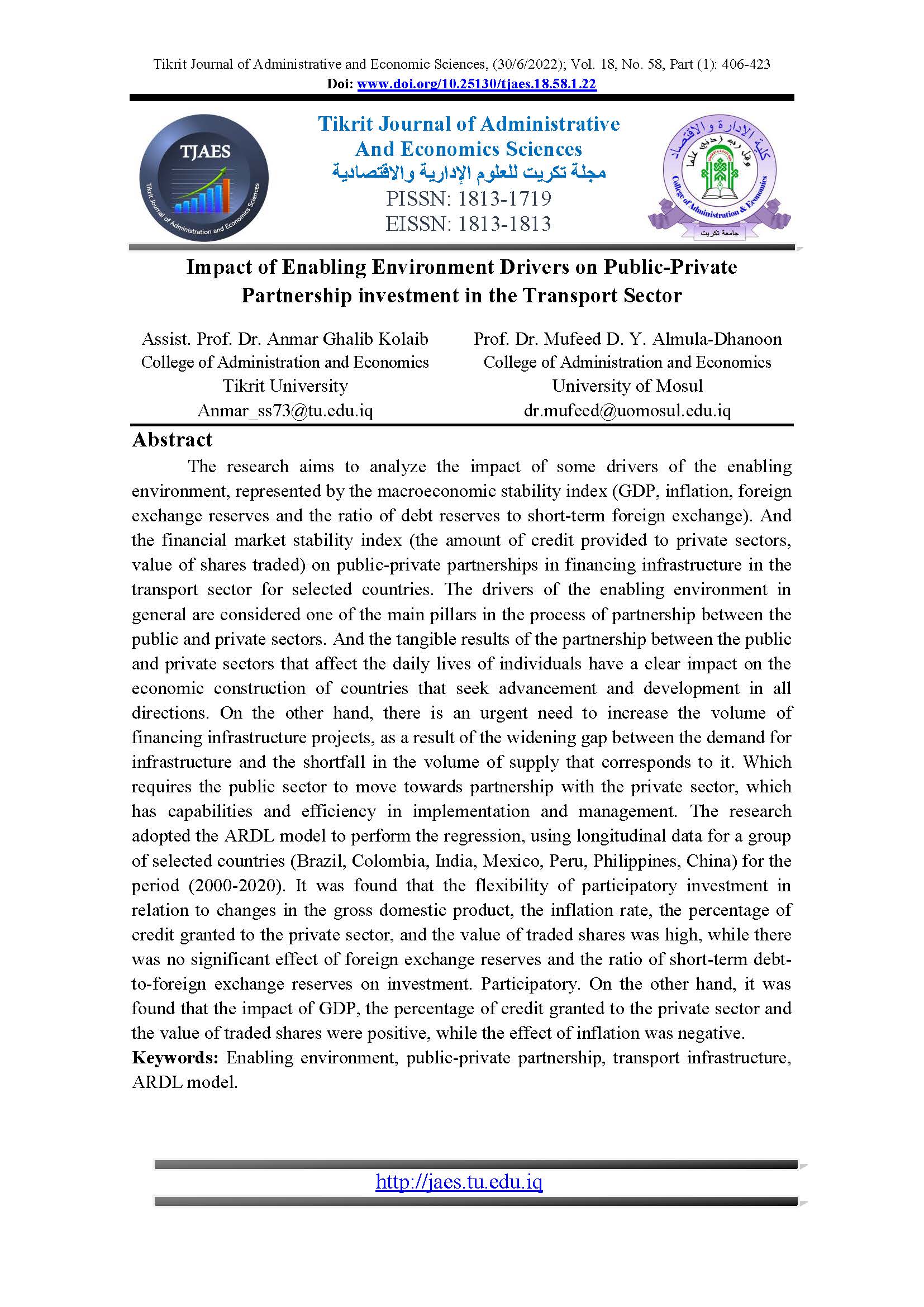Impact of Enabling Environment Drivers on Public-Private Partnership investment in the Transport Sector
Main Article Content
Abstract
The research aims to analyze the impact of some drivers of the enabling environment, represented by the macroeconomic stability index (GDP, inflation, foreign exchange reserves and the ratio of debt reserves to short-term foreign exchange). And the financial market stability index (the amount of credit provided to private sectors, value of shares traded) on public-private partnerships in financing infrastructure in the transport sector for selected countries. The drivers of the enabling environment in general are considered one of the main pillars in the process of partnership between the public and private sectors. And the tangible results of the partnership between the public and private sectors that affect the daily lives of individuals have a clear impact on the economic construction of countries that seek advancement and development in all directions. On the other hand, there is an urgent need to increase the volume of financing infrastructure projects, as a result of the widening gap between the demand for infrastructure and the shortfall in the volume of supply that corresponds to it. Which requires the public sector to move towards partnership with the private sector, which has capabilities and efficiency in implementation and management. The research adopted the ARDL model to perform the regression, using longitudinal data for a group of selected countries (Brazil, Colombia, India, Mexico, Peru, Philippines, China) for the period (2000-2020). It was found that the flexibility of participatory investment in relation to changes in the gross domestic product, the inflation rate, the percentage of credit granted to the private sector, and the value of traded shares was high, while there was no significant effect of foreign exchange reserves and the ratio of short-term debt-to-foreign exchange reserves on investment. Participatory. On the other hand, it was found that the impact of GDP, the percentage of credit granted to the private sector and the value of traded shares were positive, while the effect of inflation was negative.
Downloads
Article Details
References
Abu Saree, Muhammed, (2014), The role of public-private partnerships in the provision of public transport services-an applied study on the Egyptian case, unpublished PhD thesis, Faculty of Economics and Political Science, Cairo University, Cairo.
Ahmad, Salman, Shahnawaz Khan, Shah Wali Khan, (2016), Developing Infrastructure through Public Private Partnerships; Understanding the Elements of the Enabling Environment, Business & Economic Review: Vol. 8, Issue 1: 2016 pp. 19-34.
Akhtar, et al., (2018), Mobilizing Finance for Sustained, Inclusive and Sustainable Economic Growth, United Nations Publication, ESCAP.
https://www.unescap.org/sites/default/files/Mobilizing%20Finance_0.pdf
Babatunde, S., (2015), Developing Public Private Partnership Strategy for Infrastructure Delivery in Nigeria, Ph D Theses,
https://nrl.northumbria.ac.uk/id/eprint/27295/1/babatunde.solomon_phd.pdf
Cheung, Y. & Lai, K., (1993) A Fractional Cointegration Analysis of Purchasing Power Parity, Journal of Business and Economic Statistics, 11, 103-112.
Emirullah, C., & Hussain, M., (2014), examining public private partnerships in ASEAN countries: The role of investment climate. Theoretical and applied economics, 21-2 (591), P., 67-76.
https://citeseerx.ist.psu.edu/viewdoc/download?doi=10.1.1.1058.4661&rep=rep1&type=pdf
Galilea P., Medda, F., (2009), Analyzing the Influence of National Political and Economic Factors on the Success of Public-Private Partnerships in Transport. Número 25 Enero-Junio, 2009 ISSN: Ingeniería & Desarrollo. Universidad Del Norte. 25: 1-24. http://www.scielo.org.co/scielo.php?script=sci_arttext&pid=S0122-34612009000100001
Hammami, M., et al., (2006), Determinants of public-private partnerships in infrastructure. IMF Working Paper, 6/99
Hyun, S., et al., (2018), Determinants of Public–Private Partnerships in Infrastructure in Asia: Implications for Capital Market Development. Asian Development Bank Economics Working Paper Series, (552). file:///C:/Users/Dell/Downloads/SSRN-id3339107.pdf
Lee, M., et al., (2018), Deriving macroeconomic benefits from public–private partnerships in developing Asia, Asian Development Bank Economics Working Paper Series, (551). file:///C:/Users/Dell/Downloads/SSRN-id3339098.pdf
Narayan, P., (2005), the saving and investment nexus for China: evidence from cointegration tests. Applied economics, 37(17), 1979-1990.
PPIAF, (2009), Toolkit for Public-Private Partnerships in Roads & Highways, Enabling Environment for PPP (Module 1: Overview and Diagnosis). P82-83.
https://ppiaf.org/sites/ppiaf.org/files/documents/toolkits/highwaystoolkit/6/pdf-version/1-43.pdf
Regan, M., (2009), A survey of alternative financing mechanisms for public private partnerships, infrastructure Association of Queensland
https://www.infrastructureaustralia.gov.au/sites/default/files/2019-06/MichaelReganReport.pdf
UN, (2008), Guidebook on promoting good governance in public private partnerships, https://unece.org/sites/default/files/2022-01/ppp.pdf
UN, (2018), Mobilizing finance for sustained, inclusive and sustainable economic growth, https://www.unescap.org/sites/default/files/Mobilizing%20Finance_0.pdf
UNCTAD, (2013), World investment report, https://unctad.org/system/files/official-document/wir2013_en.pdf
World Economic Forum, (2010), Paving the way: maximizing the value of private finance in infrastructure,
http://www3.weforum.org/docs/WEF_IV_PavingTheWay_Report_2010.pdf
World Bank, (2011), towards better infrastructure conditions, constraints, and opportunities in financing public private partnerships: evidence from Cameroon, Cote D' Ivoire, Ghana, Kenya, Nigeria, and Senegal.
World Bank, (2021), World Development Indicators,
https://data.albankaldawli.org/indicator.
Yurdakul, H., et al., (2021), Macroeconomic drivers of Public Private Partnership (PPP) projects in low income and developing countries: A panel data analysis. Borsa Istanbul Review, 22-1, p 37-46, file:///C:/Users/Dell/Downloads/1-s2.0-S2214845021000028-main.pdf


